What is dermaplaning treatment? A guide for business owners
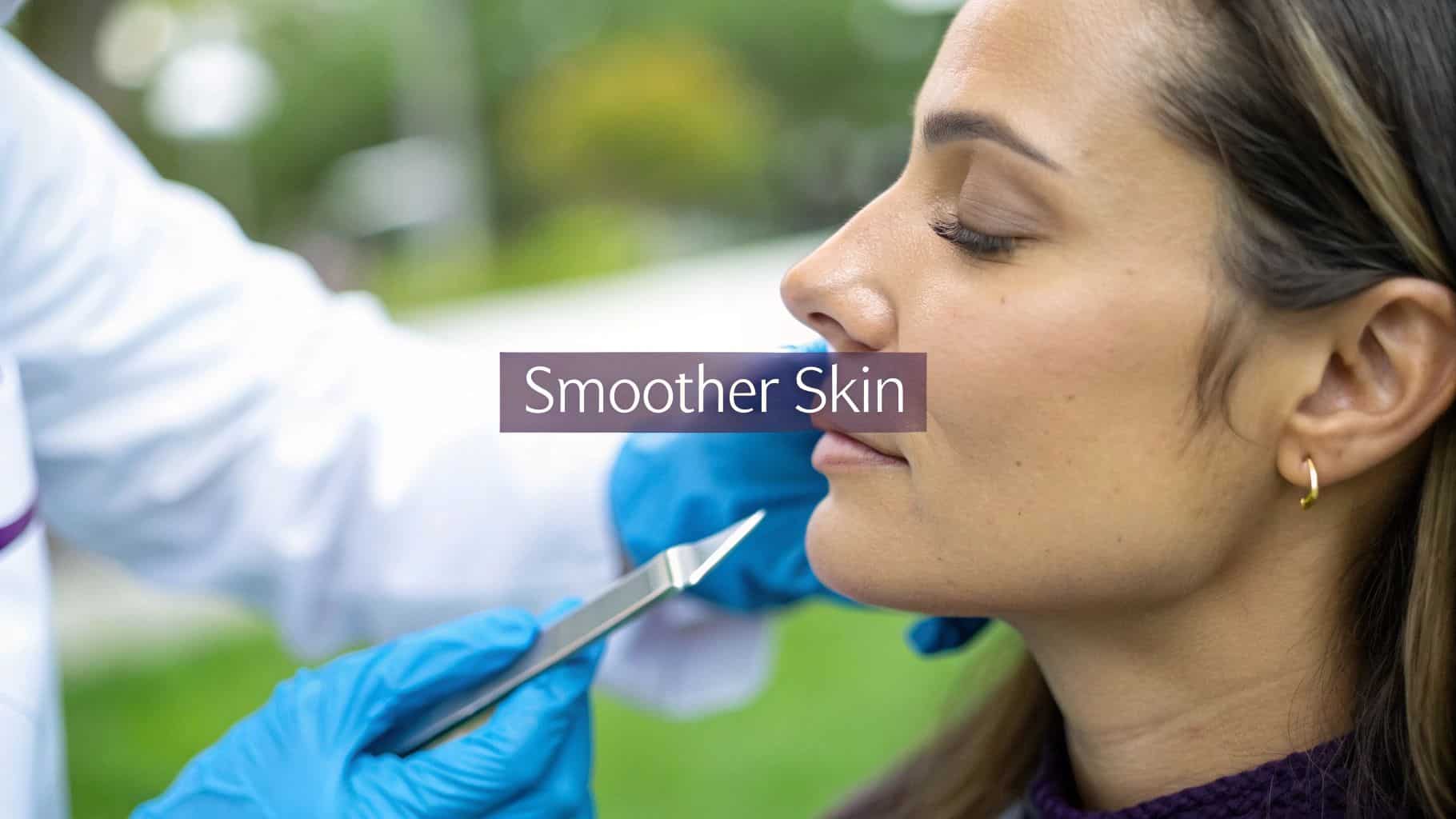
Dermaplaning is a professional skincare treatment where a trained specialist uses a sterile, surgical-grade blade to gently scrape across the skin's surface. This process has a dual benefit: it exfoliates away dead skin cells and gets rid of all that fine vellus hair we call 'peach fuzz,' leaving your client with a brighter, smoother layer of skin underneath. For your business, it's a high-demand, low-downtime service that can become a significant revenue stream.
Understanding Dermaplaning Treatment
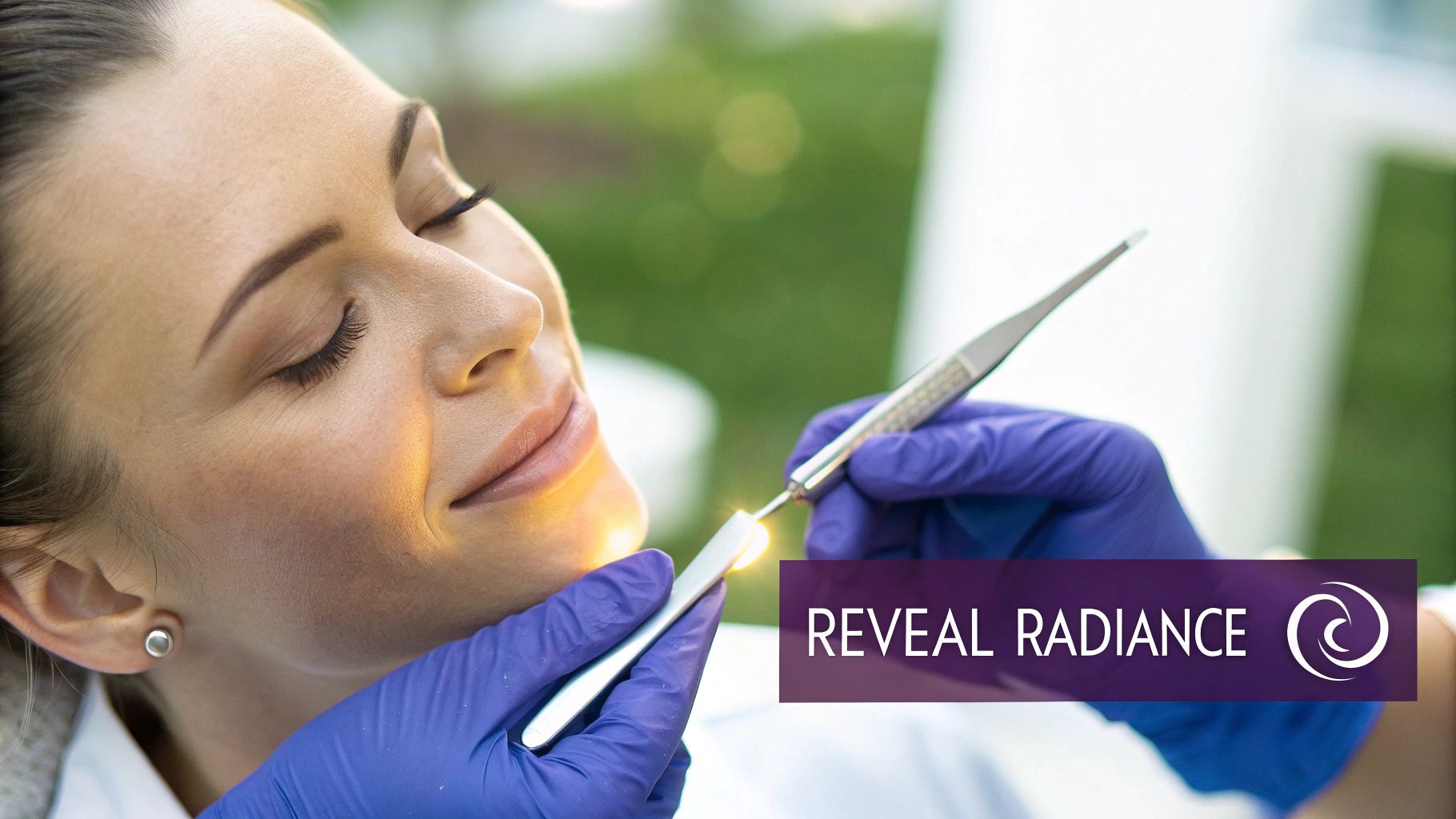
Think of dermaplaning like refinishing a beautiful piece of wood. The goal is to gently sand away the dull, weathered top layer to let the gorgeous, glowing grain shine through. It’s a completely non-invasive treatment that clients love for its instant gratification—it creates a flawless canvas that makes makeup glide on like a dream and helps all those expensive skincare products actually sink in and do their job.
That "wow" factor is a huge draw for clients, and the numbers prove it. The global market for dermaplaning tools hit about USD 612.2 million in 2023, which tells you just how much people are seeking out this service. As a business owner, this is a trend you can capitalize on.
To position this service effectively, here’s what you and your team need to know.
Dermaplaning Treatment At a Glance
Use this table to train your staff and create marketing materials that clearly explain the service.
| Aspect | Description |
|---|---|
| Treatment Type | Physical exfoliation and vellus hair removal. |
| Primary Goal | To reveal smoother, brighter skin by removing dead cells and peach fuzz. |
| Tools Used | A sterile, surgical-grade scalpel or dermatome. |
| Performed By | A licensed and trained esthetician or dermatologist. |
| Pain Level | None. It's a gentle, painless scraping sensation. |
| Downtime | Zero. Clients can return to their day immediately. |
| Best For | Dullness, uneven texture, fine lines, and creating a smooth base for makeup. |
As you can see, it's a straightforward yet highly effective treatment when performed by the right hands.
The Professional Difference
Let's be clear: this is not the same as shaving your face at home. A licensed esthetician performs this service with a level of precision and skill that you can't replicate with a disposable razor. They have a deep understanding of skin anatomy and use a specific technique that goes way beyond just removing hair—they're truly resurfacing the skin safely and effectively.
Actionable Insight: Market this professional difference. Emphasize that your certified estheticians use surgical-grade tools and techniques that cannot be safely duplicated at home. This justifies your pricing and builds client trust.
This is exactly why having a proper license is non-negotiable for anyone offering this service. As a business owner, ensuring your team is properly certified isn't just about credibility; it's about client safety, liability, and maintaining your reputation.
What Dermaplaning Achieves
Ultimately, this treatment is a fantastic multi-tasker, tackling several common skin concerns in a single, quick session. It's the perfect solution for anyone looking to refresh their appearance without committing to any downtime.
Here's what a professional session delivers:
- Physical Exfoliation: It gently sloughs off the top layer of dead skin that makes your complexion look dull and tired.
- Vellus Hair Removal: It eliminates all that fine "peach fuzz" that can trap oil and dirt, giving your skin a much smoother, softer texture.
- Enhanced Product Efficacy: By clearing the way, it allows your serums and moisturizers to penetrate deeper and work more effectively.
Actionable Insight: Create treatment packages that leverage these benefits. Offer a "Glow and Go Facial" that pairs dermaplaning with a hydrating mask, or position it as an add-on to other services. You can also explore other skin sculpting techniques to create unique, high-value service combinations.
The Dermaplaning Session Step by Step
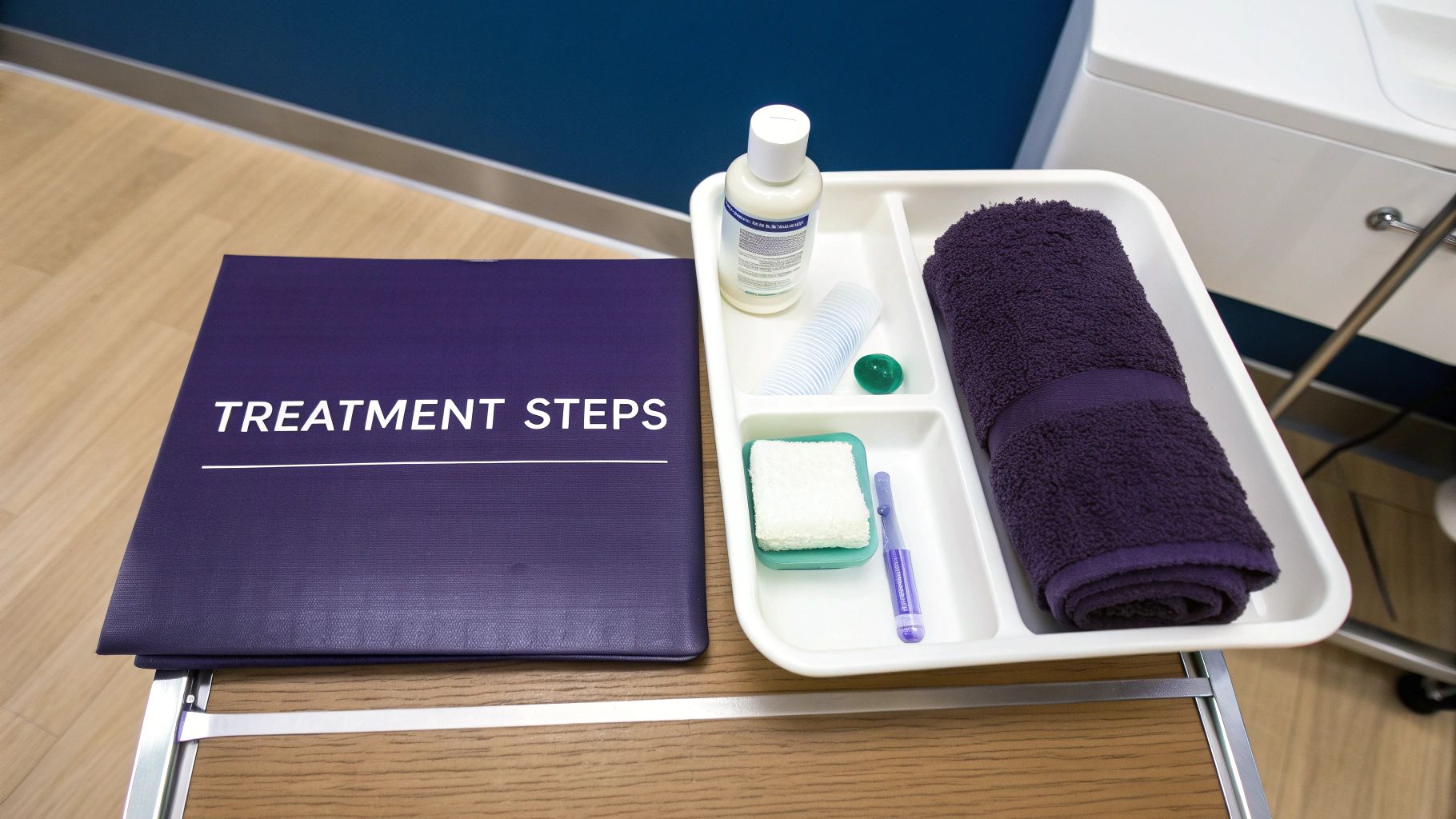
Knowing the play-by-play demystifies the whole thing, builds massive trust, and lets you walk clients through it with total confidence. Standardizing this process across your team ensures every client receives the same high-quality, safe, and relaxing experience.
A full session is more than just the main event; it’s a multi-step ritual. The whole appointment usually clocks in between 30 to 45 minutes, making it the ultimate "lunchtime facial." Clients get that instant glow-up with zero downtime, a key selling point for busy professionals.
The Initial Skin Analysis and Prep
Every great treatment starts with a consultation. Train your staff to take a close look at the client's skin to make sure dermaplaning is the right move. They must look for any red flags—like active acne, lesions, or other issues—that would make the treatment a no-go. This is non-negotiable for client safety and your liability.
Once you get the green light, it's prep time. The skin has to be squeaky clean to avoid spreading any bacteria. That means a thorough double cleanse to wipe away every last bit of makeup, oil, and daily grime.
Next up, a special prep solution is applied to gently dehydrate the skin. This step is key because it makes the surface completely dry, allowing the blade to glide like a dream without snagging on any moisture. Think of it as creating the perfect canvas for a flawless finish. The principles of sanitation are universal in our industry—you can read more about why tool hygiene is so critical in our guide on how to disinfect nail tools.
The Core Dermaplaning Procedure
With the skin perfectly prepped, the main procedure begins. Your esthetician will use a sterile, single-use, surgical-grade scalpel. Holding the skin taut with one hand, they use the other to gently stroke the blade across the skin at a precise 45-degree angle. This is where professional training and a steady hand are everything.
Working in small, controlled sections, the esthetician carefully scrapes away that top layer of dead skin cells and vellus hair. Clients often say it feels like a light tickle or a soft scraping sensation. When done right, it’s completely painless.
Actionable Insight for Training: Emphasize that the goal isn't pressure; it's a meticulous, feather-light touch. This ensures only the dull, outer layer of skin (the stratum corneum) and peach fuzz are lifted away, leaving the healthy, vibrant skin underneath totally unharmed.
Post-Treatment Calming and Protection
Once all the scraping is done, the final step is to soothe and protect that fresh, new skin. This part is just as important as the exfoliation itself and is a prime opportunity to recommend retail products.
Here's the protocol to implement:
- Application of a Calming Serum: Massage in a hydrating serum with ingredients like hyaluronic acid or aloe to calm any slight redness.
- Moisturizer: Apply a nourishing moisturizer to create a protective seal and lock in hydration.
- Sunscreen Application: This is an absolute must. Apply a broad-spectrum sunscreen with at least SPF 30. This shields that sensitive new skin from sun damage.
This complete, start-to-finish approach gets clients hooked on the results long after they've left your studio.
What Dermaplaning Actually Does for Your Clients' Skin
To effectively sell this service, your team needs to confidently articulate the benefits. This isn't just about removing "peach fuzz"; it's about delivering an instant, visible glow-up that creates loyal, repeat customers.
The biggest win here is superior physical exfoliation. By gently scraping away that top layer of dead, dull skin, the treatment immediately uncovers a fresher, more luminous complexion. This process jumpstarts cellular turnover, leading to a brighter and more even skin tone that clients can see the second they sit up.
The Ultimate Canvas for Flawless Makeup
For many clients, one of the biggest selling points is how their makeup goes on after a session. Once you've dermaplaned, the skin's surface is incredibly smooth and totally free of the vellus hair that makes foundation look cakey or patchy.
With that layer of peach fuzz gone, makeup glides on like a dream. The result is a seamless, almost airbrushed finish.
Actionable Insight: Target your marketing. Promote dermaplaning heavily before holidays, wedding season, or prom. Frame it as the perfect "event-prep facial" for clients who want to look their absolute best.
Making Their Skincare Products Finally Work Harder
Beyond the immediate aesthetics, dermaplaning has a huge functional advantage: it supercharges a client's at-home skincare routine. Once that top layer of dead cells is out of the way, you've created a clear pathway for products to penetrate deeper into the skin.
This means those pricey serums and creams your clients use can finally do their job properly. Explain it to them like this: dermaplaning primes their skin to drink up every last drop of the good stuff they're applying.
Here’s how to break down the value for a client:
- Better Product Absorption: Explain that their hyaluronic acid and vitamin C serums will be far more effective.
- A Serious Hydration Boost: With no barrier in the way, moisturizers can lock in hydration much more efficiently.
- Long-Term Skin Wins: Regular treatments can help manage concerns like fine lines and uneven texture.
Actionable Insight: Use this as a retail opportunity. After the treatment, recommend specific serums and moisturizers from your product line that are ideal for post-dermaplaning care. Explain that now is the best time to use them for maximum results.
Identifying the Ideal Dermaplaning Candidate
Not every client is a perfect match for dermaplaning. Knowing who will get that "wow" result versus who should skip it is crucial for client safety, managing expectations, and earning five-star reviews.
The dream client for this service is someone dealing with dull, dry, or sun-damaged skin. If a client complains about uneven texture, fine lines, or "peach fuzz," they are an ideal candidate. Dermaplaning is a fantastic choice for anyone craving an instant radiance boost without a second of downtime.
This little infographic breaks down exactly how the magic happens, showing the journey from treatment to the incredible results your ideal clients are looking for.
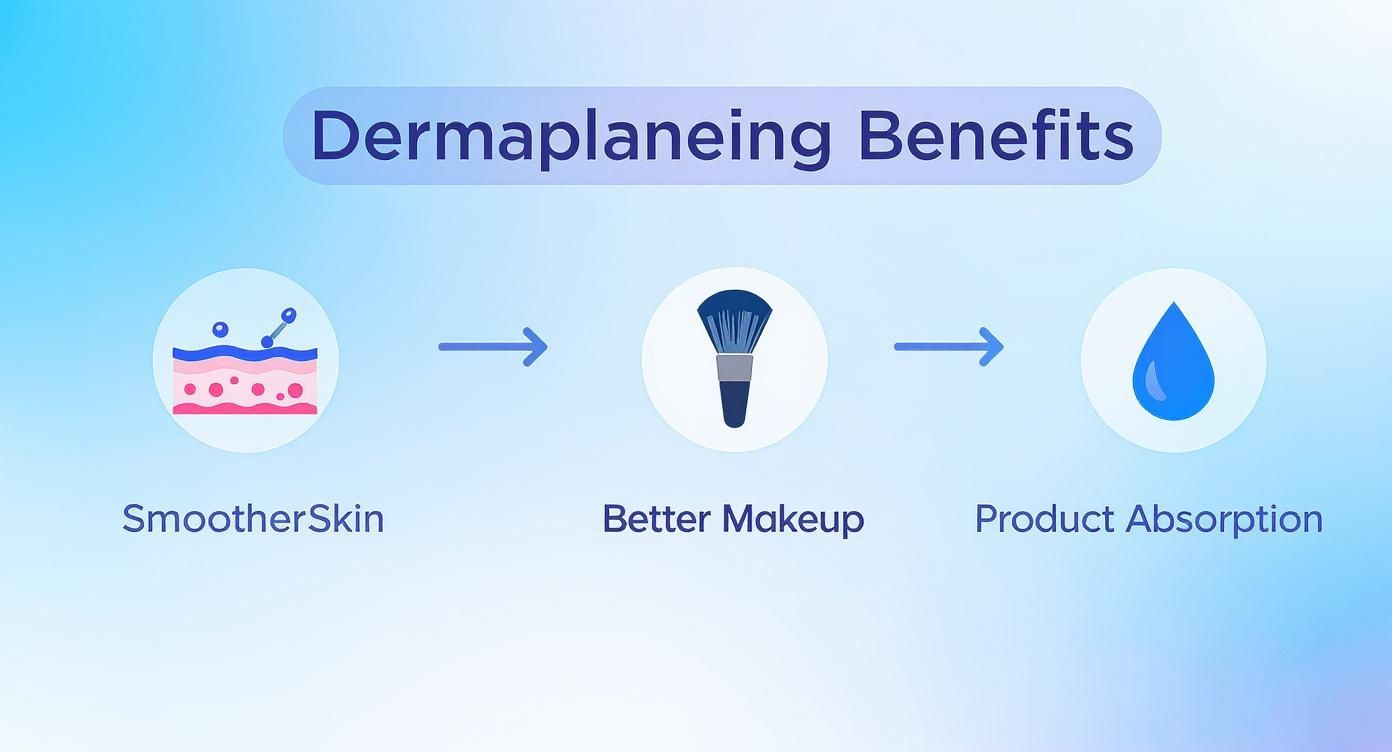
As you can see, it all starts with creating that impossibly smooth surface, which is the secret to flawless makeup and skincare products that actually sink in and do their job.
Good Candidates Versus Contraindications
There are some definite red flags to watch out for where dermaplaning is a hard no. The biggest one? Active acne. Gliding a blade over active pustules or cystic acne is a recipe for disaster—it can spread bacteria and make breakouts worse.
Similarly, clients with inflammatory skin conditions like rosacea, eczema, or psoriasis should steer clear. The exfoliation can easily trigger a flare-up.
This is why a thorough consultation is absolutely non-negotiable. It’s your chance to play detective and get the full story on your client's skin. Using detailed esthetician client consultation forms helps you document everything, ensuring you make the safest, most effective recommendation every single time. This careful screening process is what separates the pros from the amateurs.
Dermaplaning Candidacy Guide
Use this table as a quick-reference guide for your team during consultations. It’s a simple way to spot the green lights and the red flags.
| Ideal Candidates (Signs You're a Good Fit) | Contraindications (When to Avoid Dermaplaning) |
|---|---|
| Dull or Dry Skin: They want to unveil a brighter, more hydrated complexion. | Active Acne or Pustules: Big risk of spreading bacteria and worsening breakouts. |
| Fine Vellus Hair: They want to get rid of "peach fuzz" for smoother skin. | Inflammatory Conditions: Active rosacea, eczema, or psoriasis flare-ups. |
| Mature Skin: They're looking to soften the appearance of fine lines. | Highly Sensitive Skin: Prone to irritation from this level of exfoliation. |
| Uneven Skin Texture: They want a perfect canvas for makeup application. | Recent Chemical Peels or Laser: The skin is compromised and needs time to heal. |
| Good Overall Skin Health: Their skin isn't currently irritated or inflamed. | Open Sores or Lesions: High risk of infection and improper healing. |
A successful dermaplaning service starts with a great consultation and your expert ability to know who will truly benefit. Get that part right, and you'll have happy clients who can't stop raving about their luminous new glow.
Essential Dermaplaning Aftercare Practices
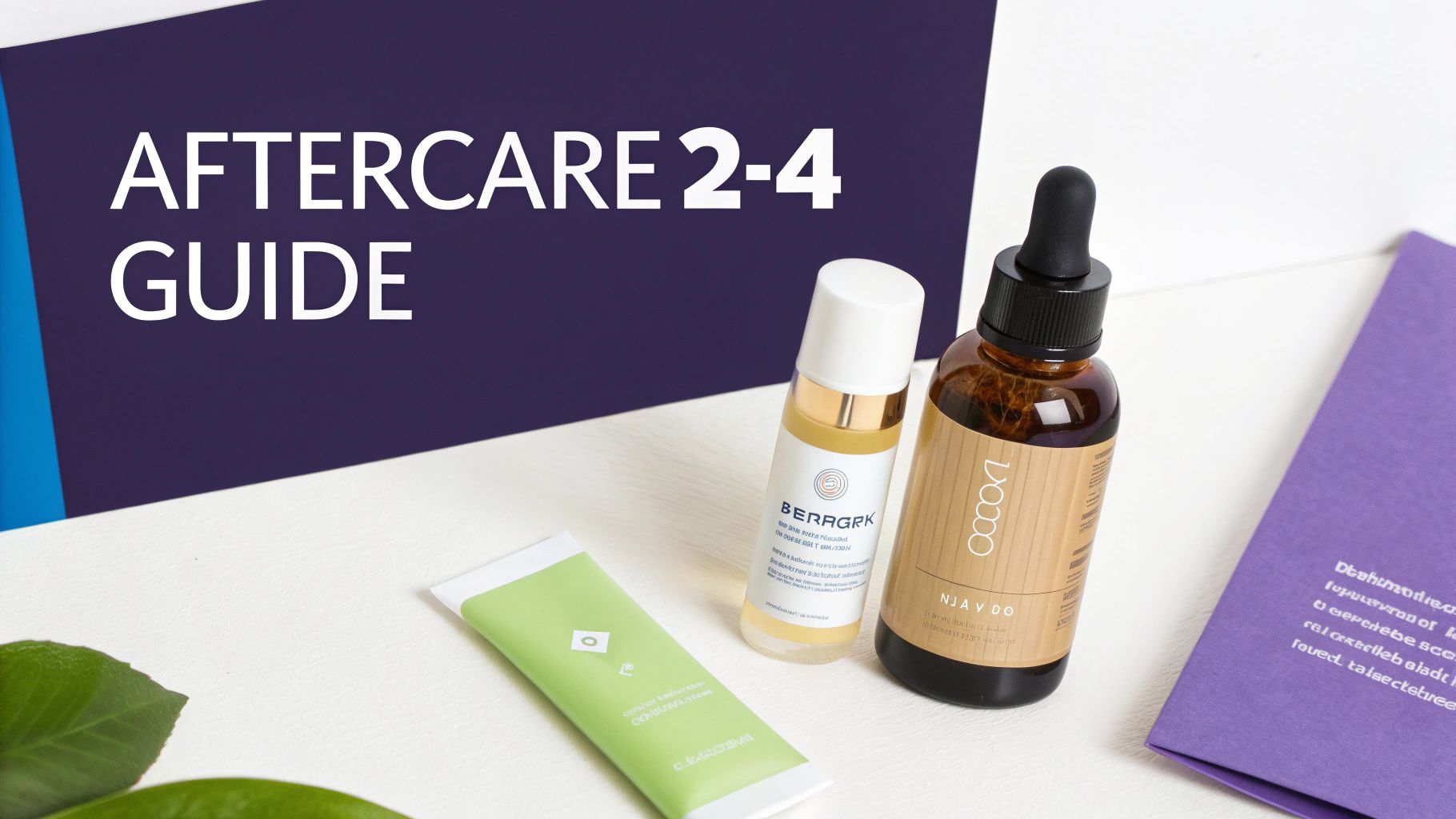
The incredible results from a dermaplaning session are secured in the days that follow. What your client does after they leave your spa is what truly locks in that glow. As a business owner, providing clear instructions is a signature of your expertise.
Actionable Insight: Create a simple, branded take-home card with these aftercare instructions. It empowers your clients, reduces the risk of post-treatment issues, and reinforces the value of your professional service. This small touch builds massive trust and encourages repeat business.
Your Client's Immediate Aftercare Plan
The first 24 to 72 hours are the most critical. During this window, the game plan is simple: calm, hydrate, and shield the skin.
Here are the non-negotiable steps to share with every single client:
- Be Gentle: Remind them to use only a mild, pH-balanced cleanser with lukewarm water. No rubbing! They should gently pat their skin dry with a soft, clean towel.
- Hydrate Intensively: This is prime time for products loaded with hyaluronic acid. This is another opportunity to recommend a specific retail product you carry.
- Avoid Irritants: For at least a day, clients must steer clear of hot tubs, saunas, steam rooms, and intense workouts that cause a lot of sweating.
The Golden Rule of Sun Protection
If there is one absolute, must-do after dermaplaning, it’s sunscreen. The treatment reveals new skin cells that are extremely susceptible to UV damage. Without proper protection, clients are at high risk of developing hyperpigmentation.
Actionable Insight for Retail: Sunscreen is your easiest and most important retail product. Always have a professional-grade, esthetician-approved SPF product at your checkout counter. Instruct every client to apply a broad-spectrum sunscreen with at least SPF 30 every single day.
Clearing Up Common Dermaplaning Myths
Misinformation can stop a potential client dead in their tracks. As a business owner, train your staff to bust the most common dermaplaning myths with clear, confident answers. This is your secret weapon to overcoming hesitation and securing bookings.
The number one fear is always the same: “Will my hair grow back thicker and darker?”
The answer is a definitive no. It’s biologically impossible. Dermaplaning removes the super-fine, soft vellus hair ("peach fuzz"). This hair is a completely different type than the coarse terminal hair on your head or legs. Slicing vellus hair at a blunt angle has zero effect on the follicle, so it can’t change its color, texture, or growth rate.
Debunking More Common Fears
Nailing these answers during a consultation builds immense trust and showcases your expertise.
Another frequent question is whether the treatment is painful. Dermaplaning is a completely painless procedure. When performed by a trained professional, the sensation is often described as a light, gentle scraping or even a tickle.
The rising demand for dermaplaning comes from a huge consumer shift toward painless, budget-friendly alternatives to more invasive procedures. Dermaplaning fits this trend perfectly, offering quick exfoliation and making skincare products work better by removing barriers like dead skin and peach fuzz. You can read the full research on this market trend.
Finally, some clients worry that dermaplaning will cause breakouts. In reality, it usually does the opposite. By clearing away the buildup of dead skin cells that can clog pores, the treatment often helps prevent future breakouts. The key is that it should never be performed on skin with active acne, as this can spread bacteria.
Got Questions About Dermaplaning? We've Got Answers.
Here are the most common questions clients ask. Having scripted, consistent answers for your team is a game-changer for making consultations smoother and giving clients the confidence they need to book.
How Often Should I Get a Dermaplaning Treatment?
For consistently bright skin, recommend a session every 3 to 4 weeks. This schedule aligns with the skin's natural 28-day renewal cycle, keeping dead skin cell buildup and peach fuzz at bay. Any more often is unnecessary and can lead to irritation. This schedule also creates a reliable, recurring revenue stream for your business.
Is Dermaplaning Painful?
Not at all. When a licensed and trained professional performs the service, dermaplaning is completely painless. Most clients find it quite relaxing. The feeling is often described as a very light, gentle scraping across the skin.
Training Point: A great esthetician holds the blade at a precise 45-degree angle and uses a feather-light touch. There should never be pain. If a client feels anything more than a gentle glide, the technique needs correction.
Can I Just Dermaplane Myself at Home?
The at-home tools are not in the same league as a professional treatment. Here’s how to explain the difference to clients:
- Pro Tools: Estheticians use a sterile, surgical-grade scalpel. This allows for the precise removal of dead skin and vellus hair that delivers professional results.
- At-Home Tools: Those gadgets are essentially tiny razors with safety guards and duller edges. They may remove some hair, but they won't provide the same level of skin-renewing exfoliation.
For the safest, most dramatic results, a professional what is dermaplaning treatment is always the best choice. It minimizes the risk of nicks, irritation, or infection and delivers a glow that a plastic drugstore razor can't match.
Ready to give your clients that flawless, radiant skin they're dreaming of? A stunning, SEO-optimized website from gohappybeauty is your first step. Check out our site to see how we help beauty pros like you attract more clients and grow your business online.
Grow your beauty business
Our focus is, and always will be, helping you improve your online presence and generate more business from your website. That is what we do, for you.

